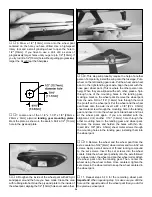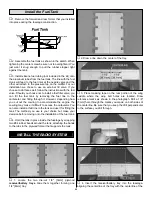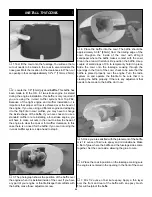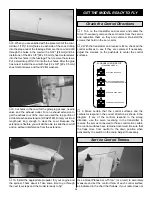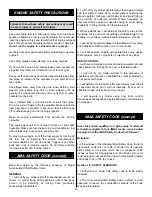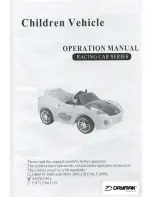
have dual rates, we recommend setting the throws at the
low rate setting.
Note: The throws are measured at the widest part of the
elevators, rudder and ailerons.
At this stage the model should be in ready-to-fly condition
with all of the systems in place including the engine, landing
gear, covering, paint, and the radio system.
❏
1. Use a felt-tip pen or 1/8"-wide tape to accurately mark
the C.G. on the top of the wing on both sides of the fuselage.
The C.G. is located 3-1/4" [82mm] back from the leading
edge of the wing as measured at the fuselage.
❏
2. With the wing attached to the fuselage, all parts of the
model installed (ready to fly) and an empty fuel tank, place
the model upside-down on a Great Planes CG Machine
™
, or
lift it upside-down at the balance point you marked.
❏
3. If the tail drops, the model is “tail heavy” and weight
must be added to the nose to balance. If the nose drops, the
model is “nose heavy” and weight must be added to the tail
to balance. At the location the receiver/battery tray are
mounted our model balanced perfectly. However, due to the
manufacturing process involved with laying up fiberglass, it
is not unusual to have some differences in the thickness of
the fiberglass, which can account for some differences in
weight required at the nose or tail. If additional weight is
required, nose weight may be easily added by using a
“spinner weight” (GPMQ4645 for the 1 oz. weight, or
GPMQ4646 for the 2 oz. weight). If spinner weight is not
practical or is not enough, use Great Planes (GPMQ4485)
“stick-on” lead. A good place to add stick-on nose weight is
to the firewall (don’t attach weight to the cowl–it is not
intended to support weight). Begin by placing incrementally
increasing amounts of weight on the bottom of the fuse over
the firewall until the model balances. Once you have
determined the amount of weight required, it can be
permanently attached. If required, tail weight may be added
by reaching into the fuse and gluing it permanently inside.
Note: Do not rely upon the adhesive on the back of the lead
weight to permanently hold it in place. Over time, fuel and
exhaust residue may soften the adhesive and cause the
weight to fall off. Use #2 sheet metal screws, RTV silicone
or epoxy to permanently hold the weight in place.
❏
4. IMPORTANT: If you found it necessary to add any
weight, recheck the C.G. after the weight has been installed.
This is where your model should balance for the first
flights. Later, you may wish to experiment by shifting the
C.G. up to 3/8" [10mm] forward or 3/8" [10mm] back to
change the flying characteristics. Moving the C.G. forward
may improve the smoothness and stability, but the model
may then require more speed for takeoff and make it
more difficult to slow for landing. Moving the C.G. aft
makes the model more maneuverable, but could also
cause it to become too difficult to control. In any case,
start at the recommended balance point and do not at
any time balance the model outside the specified range.
More than any other factor, the C.G. (balance point) can
have the greatest effect on how a model flies, and may
determine whether or not your first flight will be
successful. If you value this model and wish to enjoy it for
many flights, DO NOT OVERLOOK THIS IMPORTANT
PROCEDURE. A model that is not properly balanced will
be unstable and possibly unflyable.
Balance the Model (C.G.)
These are the recommended control surface throws:
High Rate
Low Rate
ELEVATOR:
1/2" [13mm] up
3/8" [10mm] up
1/2" [13mm] down
3/8" [10mm] down
RUDDER:
1-3/8" [35mm] right
1" [25mm] right
1-3/8" [35mm] left
1" [25mm] left
AILERONS:
5/8" [16mm] up
3/8" [10mm] up
5/8" [16mm] down
3/8" [10mm] down
FLAPS:
1-1/2" [38mm] down
1" [25mm] down
IMPORTANT: The Lancair has been extensively flown and
tested to arrive at the throws at which it flies best. Flying your
model at these throws will provide you with the greatest chance
for successful first flights. If, after you have become accustomed
to the way the Lancair flies, you would like to change the throws
to suit your taste, that is fine. However, too much control throw
could make the model difficult to control, so remember, “more is
not always better.”
31
Summary of Contents for Lancair ES
Page 40: ......








